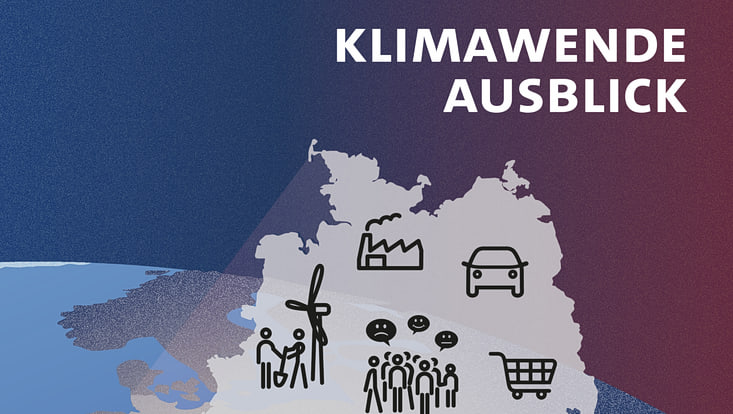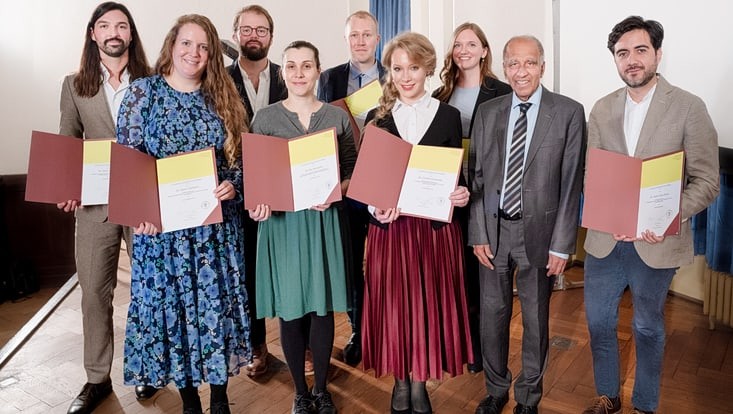and Society (CLICCS)
Climate change and adaptationSnapshot Seychelles
19 May 2025, by Stephanie Janssen
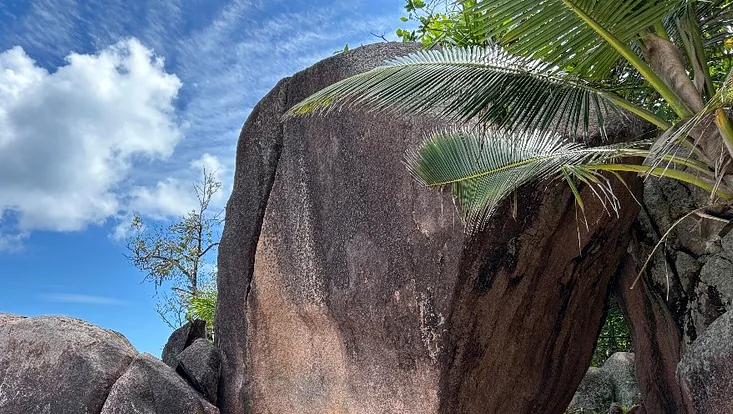
Photo: Beate Ratter
In March 2025, Beate Ratter sent us pictures and impressions of her research trip to the Seychelles, which we present here. The professor of integrative geography is an expert for climate change and adaptation measures on small islands.
Ratter holds the UNESCO Chair in “Societal Climate Research and Resilience”. She works at the CLICCS Cluster of Excellence at the University of Hamburg as well as at the Helmholtz Centre Hereon. Read how she plans to achieve the transition from knowledge to action.
.
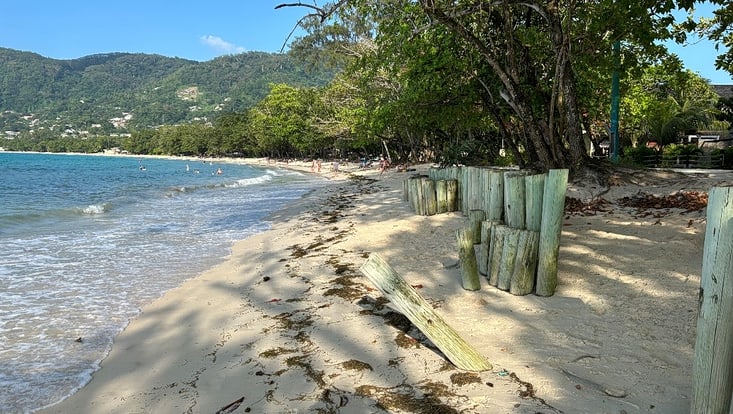
Photo: Beate Ratter
Is the sea really getting closer at Beau Vallon beach on Mahé? Or are the hotels pushing closer to the shoreline, demanding protection from the encroaching sea?
Beate Ratter, an expert in climate adaptation, reports:
“Twenty years ago, mango trees stood here, and cassava, papaya, and other food crops were cultivated. A freshwater lake served as a watering point for livestock in this bay. Now, hotels line the entire beach.
The wooden poles we see are designed to protect the hotel facilities from the invading sea – and to act as sand traps. In June and July, when the strong southeast trade winds return, these poles can become completely buried in sand and the beach may appear three times wider.
However, from November to April, the northwest monsoon brings heavy rain that washes the sand away again. This ongoing sediment dynamics is something we should be careful not to disrupt. Yet hotel investors are relentlessly pushing for growth, even in the Seychelles. Coastal squeeze is becoming an increasing problem here.”
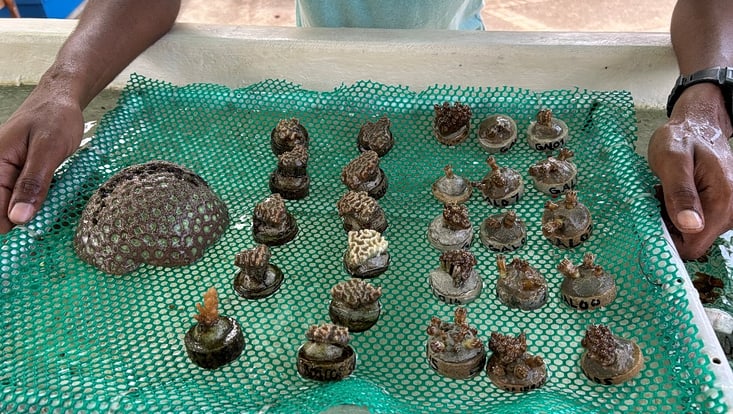
Photo: Beate Ratter
Corals are extremely important as wave breakers, sand producers, and habitats for diverse marine flora. However, climate change threatens corals through marine heatwaves and increasing ocean acidification.
Beate Ratter, an expert in climate adaptation, reports:
“During severe storms, corals can break off. Human activities also damage corals, such as when boaters carelessly drop anchors, fishermen deploy their nets, or tourists step on corals while snorkeling.
In the coral protection program “Unlock the Sea” by the Marine Conservation Society Seychelles (MCSS), individuals collect broken coral fragments from the sea, place them on cement, and grow them in tanks. Depending on the species, these fragments are then nurtured in an Ocean Nursery for up to 13 months before being reintroduced into their habitat to help rebuild coral reefs.
The program has already achieved promising results with corals that are more resilient to rising temperatures. This is crucial because only with a protective, living coral reef will the waves erode less sand from the beaches, reduce erosion, and help mitigate flooding. Already today, the road to the airport is impassable under certain weather conditions."
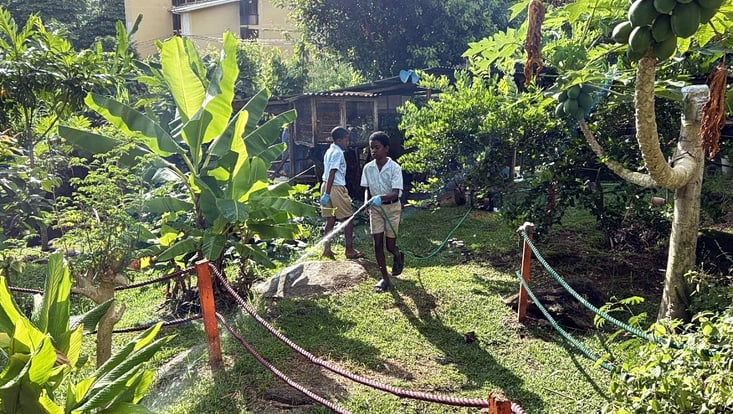
Photo: Beate Ratter
Every child can be a gardener. In the Seychelles, all schools are eco-schools. The Beau Vallon Primary School for example, won the Eco-School Award 2024.
Beate Ratter, an expert in climate adaptation, reports:
“Today I visited the eco-school and watched the schoolchildren watering plants, feeding animals and sweeping paths. These schools are a great project, they celebrated their 30th anniversary last year. All schools in the country are now eco-schools in which all students from primary to post-secondary are involved in gardening and outdoor activities together on a voluntary basis.
After their lessons, the students learn about native plants, and collaboratively grow cassava, bananas, breadfruit, avocado or lettuce, which they then sell to fund further activities. This initiative not only teaches them about traditional cultural practices but also instills a sense of responsibility—both for the giant tortoises and chickens residing at the school and for their fellow students.
As Steven Constance, the eco-school leader from Beau Vallon, aptly puts it: “It's a holistic approach to sustainability.”

Photo: Beate Ratter
Encroaching seas are a constant threat along the coasts. Being resilient means dealing with these stressors – resisting, and making the system operational again after a disaster.
Beate Ratter researches the societal resilience in the Seychelles. She reports:
“Traditionally, houses here are built on stilts, which is typical of the architecture of many tropical island societies. The sea is a permanent threat along the coasts, and people have historically made their homes more resilient by using stilts. However, due to the rapid modernization of recent decades, houses are no longer built from wood or on stilts. In the capital, Victoria, there are even numerous multi-storey apartment buildings reminiscent of “Plattenbauten“.
The socialist government of the Seychelles People’s Progressive Front (SPPF) from 1979 to 1991 shaped the cityscape and society. It enabled general access to education and healthcare, and introduced numerous environmental protection schemes.
A culture seems to have developed in which more and more responsibility is transferred to the state. The government ensures that garbage is collected, electricity and water are supplied, coasts are protected, and conservation projects are implemented. International money flows into the country as development aid or climate adaptation assistance. Good measures, which, however, displaced some of the traditional practices and individual initiatives to improve resilience.
Seychelles became the most developed country in Africa. The number of ongoing projects in the country is breathtaking. At the same time, the Seychellois are witnessing one corruption scandal after another, with the political elite enriching themselves in questionable deals. Disenchantment with politics is coupled with ascribed state responsibility. Little is expected of the elections in September, I often heard: "nothing will really change anyway, no matter who wins."

